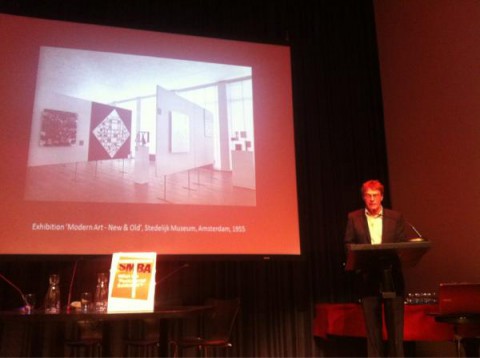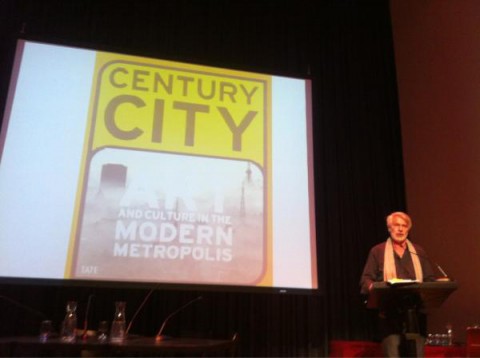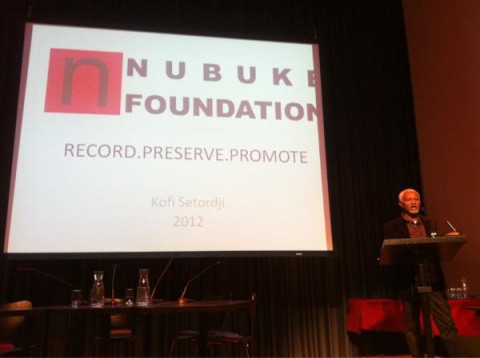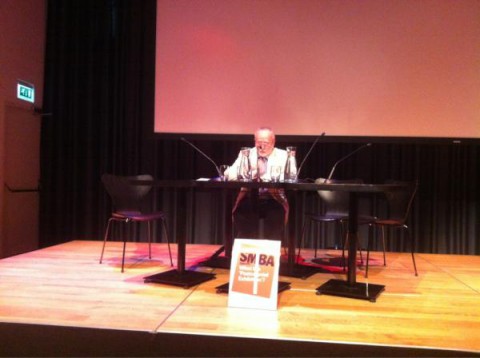In collaboration with the Stedelijk Museum, Stedelijk Museum Bureau Amsterdam organized the symposium What is a ‘Postcolonial Exhibition’? on May 25. During this day the institutional engagement with the colonial past and the postcolonial present was discussed. The symposium presented a range of institutional practices and scholarly insights to examine a specific aspect: the exhibition itself and the exhibition strategies that go alongside it.
Curator Christel Vesters wrote an extensive report on the symposium.
A first impression, by Christel Vesters
What is a ‘Postcolonial Exhibition’? kicked-off with an introduction by co-organiser Elena Sorokina, who eloquently outlined the framework for the symposium by unpacking its two primary questions: ‘what constitutes the postcolonial today?’, and ‘what is the language of an exhibition?’ If an exhibition today is no longer merely a space in which objects are put on display but has developed itself as a trans-disciplinary, narrative space in which the parameters of time and space are no longer fixed, how can exhibitions then respond to developments like globalisation, post-colonialism or to our multicultural societies?
Notwithstanding their urgency, these questions are of course burdened with a contested legacy of decennia of museum exhibitions and collecting based on the hegemonic premise of what we now dismiss as a ‘western, imperialistic gaze’. Even with the best intentions, the display and collection of non-western art in museums for modern art like the Stedelijk Museum, are always intricately linked to the western canon of art – either by including it into the grand narrative of modern art as yet another chapter, as was the case in point of some of the primitive art exhibitions organised by Sandberg in the Stedelijk Museum in 1955, or by denominating it as an new discovery and expansion of our western art horizon. Jelle Bouwhuis concluded his lecture on The ‘Global Turn’ at the Stedelijk Museum in which he traced the history of exhibitions in history of the Stedelijk with/about/including non-western art, with the critical observation that although on paper the Stedelijk seems to be engaged with non-western art, this engagement is seldom ‘capitalised’ with acquisitions of non-western art into the collection of the museum. As such the collection still remains a bastion of the western art canon.
In the afternoon session of the symposium, Chris Dercon, director of the Tate Modern, also addressed the important mission of opening up our museum collections to non-western art, or art which adheres to different canons. But with a charming anecdote Dercon also pinpointed the enormous shift in mentality of museum that is required to achieve this: After organising the critically acclaimed retrospective of Brazilian artist Helio Oiticica at Witte de With in 1992, Dercon approached the director of the Museum Boijmans van Beuningen to buy one of his works for their collection. The people at the museum responded by saying that ‘this is a very good work, but it doesn’t fit in our collection.’
So how do you start to include art from different times and different spaces into a collection that not only originated from one canonical narrative, but whose existence is based on reaffirming this canon and continuing its narrative? According to Dercon, the only way to escape this straightjacket is to make a radical and artificial cut, and just start collecting. ‘It is not enough to do something with exhibitions if it is not followed through in the collection of a museum. In the end, collections have a more profound and longer lasting impact on our views and art historical memory than exhibitions.’ Dercon continued this talk by presenting two programmes at the Tate, which introduce a different model to represent and include non-western art in a western art museum. In terms of acquisition policy, Tate has organized acquisition committees that do thorough research into the particular art context of a region, for instance Latin America, the Middle East or India. Secondly, it is important to Tate to reverse, or maybe circumvent, the old imbalanced dynamic of the ‘west taking from the east or south, but not giving anything back’. The so-called Level 2 International Series aim at doing just that, by giving a platform and support to art institutions or networks from local art scenes.
The Tate is of course one of the major institutions whose cultural power reaches far beyond the borders of the Western art world, and I couldn’t but wonder how radical these programmes actually affect changes to the principles (read: its cultural-political and economical structure) that are at the foundation of the museum. In that respect, one of the exhibitions that Jesus Maria Carrillo Castillo, head of the cultural programs department of the Reina Sofia in Madrid, introduced in his presentation, The Potosi Principle seems to have challenged the identity of the museum as an emblem of Western Modernity, in a much more critical way.
Earlier that day, another critical position was voiced by Kofi Setordji, director of the Nubuke Foundation in Accra, Ghana, who started his presentation rightly so by asking the one-million dollar question: ‘What does collecting and presenting art from former colonies do for us?’. What is post-colonial to a former colony? Driving force behind his various activities as an artist and art institution director is his belief that local artists have to start telling their story for themselves (and no one else). ‘We have to invest in our own creativity, create our own language. A country survives, because a country is creative.’
In compiling the programme of the symposium, the organisers have tried to include different voices and different perspectives and avoid yet another a one-sided representation of the discussion. But this diverse selection of speakers, all speaking from their own specific geopolitical, historical, economic and cultural position, also caused the symposium – which constitutes of course a space of its own – to be fragmented and at times without clear focus. As Natasa Ilic from the curatorial collective What, How and for Whom (WHW) from Zagreb pointed out, one may be able to apply the model of the postcolonial conditions, or postcolonialism, to the situation and developments in former Eastern Europe, at the same time the situation was very different. For WHW, the post-colonial was first and foremost the post-communist. In between the lines Ilic explicated the ideological trap the western art world fell into when they confronted the developments in former Soviet states through the model of postcolonialism: “We didn’t directly relate to the postcolonial, but the postcolonial dealt with us.” In other words: when you start from the specifics of a situation of place, conceptual models and categories like the postcolonial are bound to fall short.
It always feels a bit like a cop-out to me when at the end of a long day of lectures and presentations, the last key-note speaker radically questions the premise of the whole discussion by dismissing the legitimacy of one of its key concepts…
In this case it was Irit Rogoff who instead of wrapping up the discussion with some sweeping and insightful conclusions, opened it up again by declaring that she wasn’t sure if such a thing as the postcolonial existed, let a lone a post-colonial exhibition. Luckily Rogoff didn’t leave it with that; the deconstruction of the intellectual framework of the symposium merely served to come to a new set of terms, after all if we want to obtain a better knowledge of something, we need to question by what processes and parameters it is that we know. First of all, an exhibition with (art) objects from former colonies doesn’t make a postcolonial exhibition. These (bad) examples, which are formulated as journeys of discovery, are problematic for two reasons: a) they assume a superior knowledge and b) they reinforce the illusion of discovery, articulating the particular and the differences of ‘the other’. Instead, if we want to talk about the postcolonial, Rogoff argues, we have to think through concepts such as ‘relational geography’, the staging of loss, singularity (versus diversification) and the insistence of reading ourselves from and through ‘the other’. One of Rogoff’s main arguments is that we need to formulate new ways of relating to that which is ‘other’ and this entails new processes of knowing.
However, in a way Rogoff’s open-ended conclusion did bring the day full circle. Her plea to work from a critical epistemology and a relational geography resonated the arguments made by anthropologist Johannes Fabian almost thirty years ago in his book Time and the Other: How Antropology Makes its Objects and which he summarised in the opening lecture of the morning: in order to really communicate with the other, one (read: the western anthropologist, curator, museum director etc.) needs to share the same space and the same time. Too often any real relationship with or towards the other is undermined by what Fabian calls the challenge of coevalness: although we share the same space, we do not share the same time. We study the other, collect data, observe, and ‘its empirical presence turns into its theoretical absence’. Or, as explained by Rogoff in a reversal of terms: we read ourselves through the archive of the other.
Every culture, every presence has its own time; writing about the other, or making exhibitions about the other, keeps the other at a temporal distance. We are here and now, and they are then and there. According to Fabian, in order to share in each other’s presence, you have to share in each other’s past. You have to share each other’s histories, memories, each other’s victories and each other’s defeats. It is this fundamental desire that should inform the project of ‘the postcolonial exhibition’ if we only want to come close to the impossible task of ‘doing it right’.
Photo’s: Margriet Schavemaker





One Response to Report symposium What is a ‘Postcolonial Exhibition’?